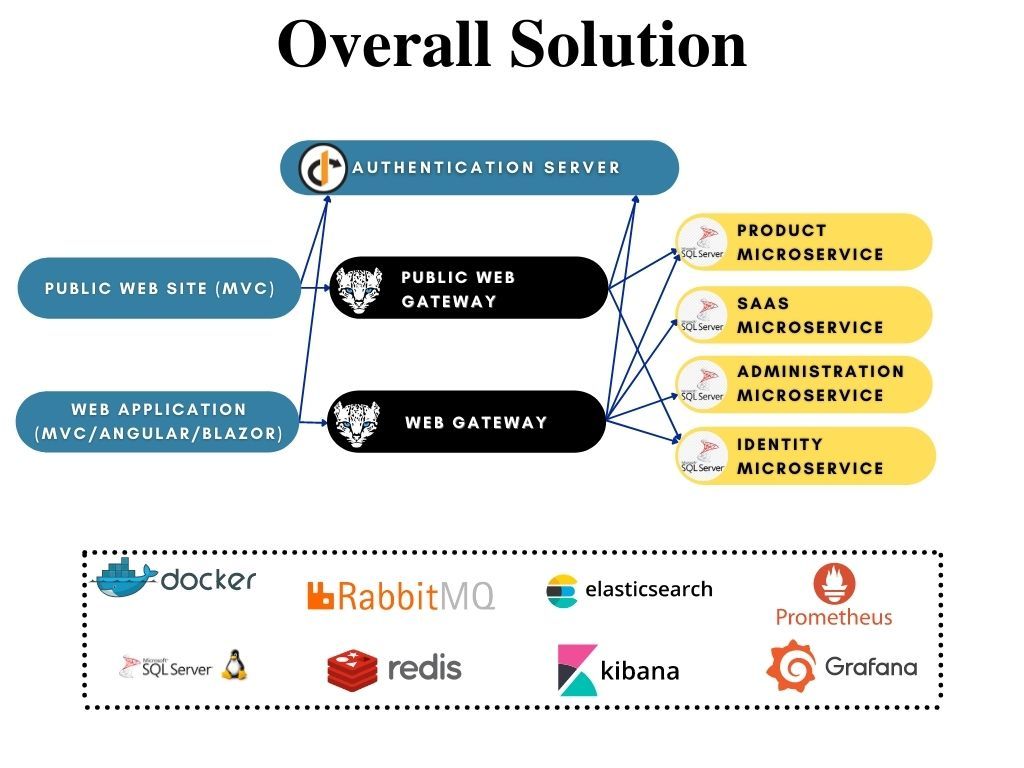Microservice Startup Template
The Microservice Startup Template is a generic solution to start a new microservice solution. While we accept that every microservice solution will be different and every system has its own design requirements and trade-offs, we believe such a startup solution is a useful starting point for most solutions.
Creating a New Microservice Solution
Read the creating a new microservice solution document to understand how to create your new microservice solution.
Overall Diagram
This section introduces the solution structure and briefly explains the solution components. The following diagram is an overview of the applications, gateways, services, databases, and other components;

Figure: Overall Diagram of the Solution (not all associations are shown, for the sake of simplicity)
- The Authentication Server is a web application serves as openid-provider that is used as a single sign-on authentication server. It hosts the login, register, forgot password, two-factor authentication, profile management... pages, OAuth endpoints and authentication-related APIs. All applications and services use this application as a central authority for authentication.
- There are two web applications in the solution (you can add more yourself);
- The Web Application is the main UI of the system. It uses the Authentication Server to make users login to the application. Then it uses the Web Gateway to access the HTTP APIs. You mostly develop your UI here. Based on your preference, it can be an MVC (Razor Pages), Angular or Blazor application.
- The Public Website is a second web application that can be used to develop your landing page for the application. If you don't need it, you can remove it. It uses the Authentication Server to make users login to the application. Then it uses the Public Web Gateway to access the HTTP APIs.
- There are two API gateways in the solution (you can add more if you need);
- The Web Gateway is a BFF (Backend for Frontend) that provides the necessary HTTP APIs to the Web Application.
- The Public Web Gateway is a BFF (Backend for Frontend) that provides the necessary HTTP APIs to the Public Web Application.
- There are four microservices coming with the solution (you can split existing ones and add new ones);
- Identity Microservice is used to manage users, roles, clients, resources... in the system.
- SaaS Microservice is used to manage tenants and editions for a multi-tenant system. If your system is not multi-tenant, you can remove this service and its database from the solution.
- Administration Microservice is mostly related to infrastructure requirements like permissions, settings, audit logs, dynamic localization and BLOB storing. This service and the related database can be split based on your design decisions.
- Product Microservice is an example microservices that can be investigated to develop your own microservices.
- There are four databases, each is owned by the related microservice. Databases are SQL Server with EF Core integrated in the applications. You can switch to another RDBMS or MongoDB for any of them. Administration and SaaS databases are used by other services since they contains cross-cutting style data (like permissions and audit logs) that is needed by all services. The reasons behind this design decision will be discussed and alternative implementations will be explained.
- There are some infrastructure services are configured in the solution (they are configured to run with docker-compose and also with Tye);
- Redis is used as a distributed cache server.
- RabbitMQ is used as a distributed event/message bus.
- ElasticSearch is used as a central point to write application logs.
- Kibana is used to visualize the logs in the Elasticsearch database.
- Grafana is used to compose observability dashboards.
- Prometheus is used for event monitoring and alerting.
- Sql-Server-Linux is used for running the database in a container. The default exposed port is 1434.


























































